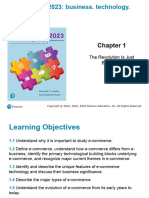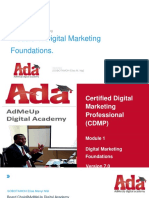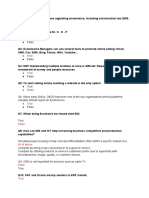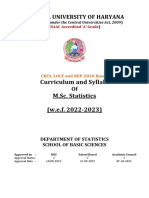100%(1)100% found this document useful (1 vote)
159 viewsE-Commerce 2019: Business. Technology. Society.: Fifteenth Edition, Global Edition
E-Commerce 2019: Business. Technology. Society.: Fifteenth Edition, Global Edition
Uploaded by
jojojoCopyright:
© All Rights Reserved
Available Formats
Download as PPTX, PDF, TXT or read online from Scribd
E-Commerce 2019: Business. Technology. Society.: Fifteenth Edition, Global Edition
E-Commerce 2019: Business. Technology. Society.: Fifteenth Edition, Global Edition
Uploaded by
jojojo100%(1)100% found this document useful (1 vote)
159 views26 pagesOriginal Title
Chapter-1
Copyright
© © All Rights Reserved
Available Formats
PPTX, PDF, TXT or read online from Scribd
Share this document
Did you find this document useful?
Is this content inappropriate?
Copyright:
© All Rights Reserved
Available Formats
Download as PPTX, PDF, TXT or read online from Scribd
Download as pptx, pdf, or txt
100%(1)100% found this document useful (1 vote)
159 views26 pagesE-Commerce 2019: Business. Technology. Society.: Fifteenth Edition, Global Edition
E-Commerce 2019: Business. Technology. Society.: Fifteenth Edition, Global Edition
Uploaded by
jojojoCopyright:
© All Rights Reserved
Available Formats
Download as PPTX, PDF, TXT or read online from Scribd
Download as pptx, pdf, or txt
You are on page 1of 26
E-commerce 2019: Business. Technology.
Society.
Fifteenth Edition, Global Edition
Chapter 1
Introduction to
E-commerce
Copyright © 2020 Pearson Education Ltd. All Rights Reserved
Learning Objectives
1.1 Understand why it is important to study e-commerce.
1.2 Define e-commerce, understand how e-commerce differs from e-business,
identify the primary technological building blocks underlying e-commerce, and
recognize major current themes in e-commerce.
1.3 Identify and describe the unique features of e-commerce technology and
discuss their business significance.
1.4 Describe the major types of e-commerce.
1.5 Understand the evolution of e-commerce from its early years to today.
1.6 Describe the major themes underlying the study of e-commerce.
1.7 Identify the major academic disciplines contributing to e-commerce.
Copyright © 2020 Pearson Education Ltd. All Rights Reserved
The First Thirty Seconds
• First two decades of e-commerce
– Just the beginning
– Rapid growth and change
• Technologies evolve at exponential rates
– Disruptive business change
– New opportunities
• Why study e-commerce
– Understand opportunities and risks
– Analyze e-commerce ideas, models, issues
Copyright © 2020 Pearson Education Ltd. All Rights Reserved
Introduction to E-commerce
• Use of Internet to transact business
– Includes Web, mobile browsers and apps
• More formally:
– Digitally enabled commercial transactions between and
among organizations and individuals
Copyright © 2020 Pearson Education Ltd. All Rights Reserved
The Difference between E-commerce
and E-business
• E-business:
– Digital enabling of transactions and processes within a
firm, involving information systems under firm’s control
– Does not include commercial transactions involving an
exchange of value across organizational boundaries
Copyright © 2020 Pearson Education Ltd. All Rights Reserved
Copyright © 2020 Pearson Education Ltd. All Rights Reserved
Technological Building Blocks
Underlying E-commerce
• Internet
• World Wide Web
– H TM L
– Deep Web v s “surface” Web
ersu
• Mobile platform
– Mobile apps
Copyright © 2020 Pearson Education Ltd. All Rights Reserved
Insight on Technology: Will Apps Make
the Web Irrelevant?
• Class Discussion
– What are the advantages and disadvantages of apps,
compared with websites, for mobile users?
– What are the benefits of apps for content owners and
creators?
– Will apps eventually make the Web irrelevant? Why or why
not?
Copyright © 2020 Pearson Education Ltd. All Rights Reserved
Major Trends in E-commerce
• Business trends include:
– All forms of e-commerce show very strong growth
• Technology trends include:
– Mobile platform has made mobile e-commerce reality
• Societal trends include:
– Increased online social interaction and sharing
Copyright © 2020 Pearson Education Ltd. All Rights Reserved
Unique Features of E-commerce
Technology (1 of 2)
Copyright © 2020 Pearson Education Ltd. All Rights Reserved
Unique Features of E-commerce
Technology (2 of 2)
1. Ubiquity
2. Global reach
3. Universal standards
4. Information richness
5. Interactivity
6. Information density
7. Personalization/customization
8. Social technology
Copyright © 2020 Pearson Education Ltd. All Rights Reserved
Types of E-commerce
• Business-to-Consumer (B2C)
• Business-to-Business (B2B)
• Consumer-to-Consumer (C2C)
• Mobile e-commerce (M-commerce)
• Social e-commerce
• Local e-commerce
Copyright © 2020 Pearson Education Ltd. All Rights Reserved
Figure 1.5 The Growth of B2C E-
commerce in the United States
Copyright © 2020 Pearson Education Ltd. All Rights Reserved
Figure 1.7 The Growth of B2B E-
commerce in the United States
Copyright © 2020 Pearson Education Ltd. All Rights Reserved
Figure 1.8 The Growth of M-commerce
in the United States
Copyright © 2020 Pearson Education Ltd. All Rights Reserved
E-commerce: A Brief History (1 of 4)
• Precursors
– Baxter Healthcare modem-based system
– Order entry systems
– Electronic Data Interchange (EDI) standards
– French Minitel
Copyright © 2020 Pearson Education Ltd. All Rights Reserved
E-commerce: A Brief History (2 of 4)
• 1995–2000: Invention
– Sale of simple retail goods
– Limited bandwidth and media
– Euphoric visions of
▪ Friction-free commerce
▪ First-mover advantages
– Dot-com crash of 2000
Copyright © 2020 Pearson Education Ltd. All Rights Reserved
E-commerce: A Brief History (3 of 4)
• 2001–2006: Consolidation
– Emphasis on business-driven approach
– Traditional large firms expand presence
– Start-up financing shrinks
– More complex products and services sold
– Growth of search engine advertising
– Business web presences expand
Copyright © 2020 Pearson Education Ltd. All Rights Reserved
E-commerce: A Brief History (4 of 4)
• 2007–Present: Reinvention
– Rapid growth of:
▪ Web 2.0, including online social networks
▪ Mobile platform
▪ Local commerce
▪ On-demand service economy
– Entertainment content develops as source of revenues
– Transformation of marketing
Copyright © 2020 Pearson Education Ltd. All Rights Reserved
Figure 1.10 Periods in the Development
of E-commerce
Copyright © 2020 Pearson Education Ltd. All Rights Reserved
Assessing E-commerce (1 of 2)
• Stunning technological success
• Early years a mixed business success
– Few early dot-coms have survived
– Online sales growing rapidly
• Many early visions not fulfilled
– Price dispersion
– Information asymmetry
– New intermediaries
Copyright © 2020 Pearson Education Ltd. All Rights Reserved
Assessing E-commerce (2 of 2)
• Other surprises
– Fast-follower advantages
– Start-up costs
– Impact of mobile platform
– Emergence of on-demand e-commerce
Copyright © 2020 Pearson Education Ltd. All Rights Reserved
Understanding E-commerce:
Organizing Themes
• Technology:
– Development and mastery of digital computing and
communications technology
• Business:
– New technologies present businesses with new ways of
organizing production and transacting business
• Society:
– Intellectual property, individual privacy, public welfare
policy
Copyright © 2020 Pearson Education Ltd. All Rights Reserved
Figure 1.11 The Internet and the
Evolution of Corporate Computing
Copyright © 2020 Pearson Education Ltd. All Rights Reserved
Academic Disciplines Concerned with
Technology
• Technical
– Computer science, management science, information
systems
• Behavioral
– Information systems research, economics, marketing,
management, finance/accounting, sociology
Copyright © 2020 Pearson Education Ltd. All Rights Reserved
Careers in E-commerce
• Position: Category specialist in E-commerce Retail Program
• Qualification/Skills
• Preparing for the Interview
• Possible Interview Questions
Copyright © 2020 Pearson Education Ltd. All Rights Reserved
You might also like
- Digital Marketing Strategy Development - Marketing MixDocument55 pagesDigital Marketing Strategy Development - Marketing MixMai Sang NguyễnNo ratings yet
- Faculty Development ProgramDocument13 pagesFaculty Development Programmarlon anzano100% (10)
- Laudon Mis15 PPT ch01Document48 pagesLaudon Mis15 PPT ch01Aljohara bin dakheelNo ratings yet
- Sixteenth Edition: The Revolution Is Just BeginningDocument30 pagesSixteenth Edition: The Revolution Is Just BeginningMoen 693No ratings yet
- Week 13.. - Laudon-Traver - Ec15 - PPT - ch12 - PPTDocument58 pagesWeek 13.. - Laudon-Traver - Ec15 - PPT - ch12 - PPTmuniraNo ratings yet
- Sharda dss10 PPT 01Document41 pagesSharda dss10 PPT 01Aniket KaushikNo ratings yet
- FS 101 Lesson 1 - Lesson 2Document3 pagesFS 101 Lesson 1 - Lesson 2Caye TVblogs50% (2)
- Project-Based Curriculum Development Rationale: BullyingDocument8 pagesProject-Based Curriculum Development Rationale: Bullyingapi-340273358No ratings yet
- EC Chapter 1Document31 pagesEC Chapter 1RahafNo ratings yet
- Chapter 1Document28 pagesChapter 1Visha KupusamyNo ratings yet
- Laudon-Traver Ec17 PPT Ch01 AccessibleDocument29 pagesLaudon-Traver Ec17 PPT Ch01 AccessibleAminul RanaNo ratings yet
- Laudon - Mis17 - PPT - ch10 (1) - 19815641Document33 pagesLaudon - Mis17 - PPT - ch10 (1) - 19815641Karim UddinNo ratings yet
- Laudon-Traver Ec15 PPT Ch01-Rev AccessiblePPT-ctDocument29 pagesLaudon-Traver Ec15 PPT Ch01-Rev AccessiblePPT-ctKhleel IfranjiNo ratings yet
- Chapter 2. E-Commerce Business Models and ConceptsDocument46 pagesChapter 2. E-Commerce Business Models and Conceptschichii01No ratings yet
- Laudon-Traver Ec16 PPT ch02 AccessibleDocument42 pagesLaudon-Traver Ec16 PPT ch02 AccessibleconstantinetenebreNo ratings yet
- (In Class) W2 - MIS - Global E-Business and CollaborationDocument52 pages(In Class) W2 - MIS - Global E-Business and CollaborationQuỳnh NguyễnNo ratings yet
- Laudon - EC16 - TB - Chapter 1Document21 pagesLaudon - EC16 - TB - Chapter 1ailoson9iNo ratings yet
- S1.1 Laudon - Mis17 - PPT - ch05Document48 pagesS1.1 Laudon - Mis17 - PPT - ch05devilryder31No ratings yet
- Laudon - EC16 - TB - Chapter 4Document24 pagesLaudon - EC16 - TB - Chapter 4ailoson9iNo ratings yet
- MIS Midterms QUIZ 2 (Key)Document26 pagesMIS Midterms QUIZ 2 (Key)Don Erick BonusNo ratings yet
- CH 03 PPTDocument32 pagesCH 03 PPTshajibayliNo ratings yet
- Foundations and Technologies For Decision MakingDocument53 pagesFoundations and Technologies For Decision MakingJose Angelo ArboledaNo ratings yet
- Laudon-Traver Ec16 PPT Ch09 AccessibleDocument50 pagesLaudon-Traver Ec16 PPT Ch09 AccessibleThao PhuongNo ratings yet
- E-Commerce 2019: Business. Technology. Society.: Fifteenth EditionDocument45 pagesE-Commerce 2019: Business. Technology. Society.: Fifteenth EditionAhmed Deq MuseNo ratings yet
- E CommerceDocument162 pagesE CommerceSurakshya PokhrelNo ratings yet
- MIS Question Ans Answers ch1,2,3Document18 pagesMIS Question Ans Answers ch1,2,3Tamaada JbNo ratings yet
- Chapter 12. B2B E Commerce Supply Chain Management and Collaborative CommerceDocument58 pagesChapter 12. B2B E Commerce Supply Chain Management and Collaborative CommerceThiên HươngNo ratings yet
- Laudon Traver Ec16 PPT Ch07 Accessible 26022023 080500pmDocument46 pagesLaudon Traver Ec16 PPT Ch07 Accessible 26022023 080500pmGreson JamesNo ratings yet
- Introduction To Information and Communication Technology: Lecture 11: E-CommerceDocument24 pagesIntroduction To Information and Communication Technology: Lecture 11: E-Commerceusman sheikhNo ratings yet
- Lecture 2Document62 pagesLecture 2sofeaNo ratings yet
- The Information Systems Strategy TriangleDocument39 pagesThe Information Systems Strategy Trianglefuad9292100% (2)
- Barringer - Ent6 - 11 - Unique Marketing IssuesDocument38 pagesBarringer - Ent6 - 11 - Unique Marketing Issuescleopatra sewowNo ratings yet
- Chapter Five Management of Information SystemsDocument30 pagesChapter Five Management of Information SystemsSnn News TubeNo ratings yet
- Fundamentals of Information Systems, Seventh Edition: Electronic and Mobile Commerce and Enterprise SystemsDocument71 pagesFundamentals of Information Systems, Seventh Edition: Electronic and Mobile Commerce and Enterprise SystemsTawanda MahereNo ratings yet
- ICT Policy and StrategyDocument32 pagesICT Policy and StrategySalim HassenNo ratings yet
- Laudon Mis15 PPT Ch10Document34 pagesLaudon Mis15 PPT Ch10Sanh NguyệtNo ratings yet
- Sixteenth Edition: Securing Information SystemsDocument47 pagesSixteenth Edition: Securing Information SystemsQuỳnh NguyễnNo ratings yet
- MPP Scheme of Work 2022-2023 Semester 2Document4 pagesMPP Scheme of Work 2022-2023 Semester 2Nhi SionNo ratings yet
- Laudon-Traver Ec15 PPT Ch04-Rev AccessiblePPT-ctDocument67 pagesLaudon-Traver Ec15 PPT Ch04-Rev AccessiblePPT-ctNhi Mộc100% (1)
- Laudon Traver Ec16 PPT Ch10 Accessible 26022023 080719pmDocument38 pagesLaudon Traver Ec16 PPT Ch10 Accessible 26022023 080719pmGreson JamesNo ratings yet
- Fundamentals of Information Systems, Seventh EditionDocument56 pagesFundamentals of Information Systems, Seventh EditionTawanda MahereNo ratings yet
- CH 1 MIS2023 SpringDocument52 pagesCH 1 MIS2023 SpringshajibayliNo ratings yet
- CDMP7.1 Slides DigitalMarketingFoundationsDocument119 pagesCDMP7.1 Slides DigitalMarketingFoundationsAbdoul karimNo ratings yet
- How Can E-Commerce Technologies Be Used To Improve A Firm's Value Web?Document2 pagesHow Can E-Commerce Technologies Be Used To Improve A Firm's Value Web?Dương Phong Nguyên0% (1)
- Management Information Systems: Managing The Digital Firm, 12e Authors: Kenneth C. Laudon and Jane P. LaudonDocument48 pagesManagement Information Systems: Managing The Digital Firm, 12e Authors: Kenneth C. Laudon and Jane P. LaudonAvishek PaulNo ratings yet
- E-Commerce Chapter 4Document57 pagesE-Commerce Chapter 4Ngọc Hà BảoNo ratings yet
- Lecture 5Document77 pagesLecture 5sofea100% (1)
- Quiz EcommerceDocument12 pagesQuiz EcommercePhương ThảoNo ratings yet
- Lesson Four-E-CommerceDocument40 pagesLesson Four-E-CommerceWambui KaragoNo ratings yet
- Unit 1 Fundamental of E-Commerce (Bba-606) - CompleteDocument56 pagesUnit 1 Fundamental of E-Commerce (Bba-606) - CompleteGaurav VikalNo ratings yet
- Laudon - EC16 - TB - Chapter 3Document21 pagesLaudon - EC16 - TB - Chapter 3ailoson9iNo ratings yet
- Recognizing Generating Ideas: Opportunities andDocument40 pagesRecognizing Generating Ideas: Opportunities andghufran almazNo ratings yet
- The Strategy ProcessDocument25 pagesThe Strategy ProcessSANG HOANG THANHNo ratings yet
- Laudon-Traver Ec16 PPT ch11 AccessibleDocument31 pagesLaudon-Traver Ec16 PPT ch11 Accessibleanhnph21No ratings yet
- CH 9 Digital Media Channels - Social Media1Document41 pagesCH 9 Digital Media Channels - Social Media1Pedro Luis Jimenez MarteNo ratings yet
- CCW322 Digital Marketing Lecture Notes 1Document285 pagesCCW322 Digital Marketing Lecture Notes 1Karnan SuganyaNo ratings yet
- CHAPTER 5 Sales ManagementDocument50 pagesCHAPTER 5 Sales ManagementFelicia TangNo ratings yet
- PPT-Information Systems For Competitive AdvantageDocument73 pagesPPT-Information Systems For Competitive AdvantageDEBDOOT GHOSHNo ratings yet
- Analyze E-Commerce Business ModelsDocument23 pagesAnalyze E-Commerce Business Modelschichii01No ratings yet
- Case Study PDFDocument15 pagesCase Study PDFRani100% (1)
- Laudon Traver Ec16 PPT Ch07 Accessible 04102022 025213pmDocument30 pagesLaudon Traver Ec16 PPT Ch07 Accessible 04102022 025213pmnimra nazimNo ratings yet
- CH1 Information Systems in Global BusinessDocument40 pagesCH1 Information Systems in Global BusinessrexieaceNo ratings yet
- Week 1 - 11Document35 pagesWeek 1 - 11asdasdNo ratings yet
- Tutorial FIN221 Chapter 3 - Part 2 (Q&A)Document13 pagesTutorial FIN221 Chapter 3 - Part 2 (Q&A)jojojoNo ratings yet
- IPPTChap006 - DonrDocument34 pagesIPPTChap006 - DonrjojojoNo ratings yet
- FIN221 Chapter 3 - (Q&A)Document15 pagesFIN221 Chapter 3 - (Q&A)jojojoNo ratings yet
- Tutorial FIN221 Chapter 3 - Part 1 (Q&A)Document17 pagesTutorial FIN221 Chapter 3 - Part 1 (Q&A)jojojoNo ratings yet
- Tutorial FIN221 Chapter 2 (Q&A) - Part TwoDocument11 pagesTutorial FIN221 Chapter 2 (Q&A) - Part TwojojojoNo ratings yet
- FIN221 Chapter 1Document35 pagesFIN221 Chapter 1jojojoNo ratings yet
- E-Commerce 2019: Business. Technology. Society.: Fifteenth Edition, Global EditionDocument40 pagesE-Commerce 2019: Business. Technology. Society.: Fifteenth Edition, Global EditionjojojoNo ratings yet
- FIN221 Chapter 3Document45 pagesFIN221 Chapter 3jojojoNo ratings yet
- ZBG7 Chapter 04 AccessibleDocument38 pagesZBG7 Chapter 04 AccessiblejojojoNo ratings yet
- BSBPMG632 Self-Study GuideDocument4 pagesBSBPMG632 Self-Study GuidegurpreetNo ratings yet
- Meet Miss PrioreDocument2 pagesMeet Miss Prioreapi-481193467No ratings yet
- M.Sc. Statistics NEP Syllabus Wef 2022-23-1Document67 pagesM.Sc. Statistics NEP Syllabus Wef 2022-23-1Prashant SharmaNo ratings yet
- Advertisement of RecruitmentDocument10 pagesAdvertisement of Recruitmenthrocking1No ratings yet
- FIELD STUDY Towards Becoming A Teacher 1Document21 pagesFIELD STUDY Towards Becoming A Teacher 1Evcha Wangag100% (3)
- Desired Outcomes of Education SingaporeDocument2 pagesDesired Outcomes of Education SingaporeJanaky VasuNo ratings yet
- NSTP 2 Syllabus Secon SemDocument3 pagesNSTP 2 Syllabus Secon SemJohn Kenneth EspirituNo ratings yet
- PT3 Q3 Movie AnalysisDocument2 pagesPT3 Q3 Movie AnalysisPaolo A. SarmientoNo ratings yet
- CV - Teboho - Sematlane SCLC JV1Document5 pagesCV - Teboho - Sematlane SCLC JV1Kidist AlemayehuNo ratings yet
- Activity Proposal FormDocument3 pagesActivity Proposal FormFitz MagbanuaNo ratings yet
- Department of Education: 2024 School-Based Midyear In-Service Training For TeachersDocument17 pagesDepartment of Education: 2024 School-Based Midyear In-Service Training For TeachersSano SukiNo ratings yet
- Position Paper On Honour Killings Matei HurjuiDocument3 pagesPosition Paper On Honour Killings Matei HurjuiMateiNo ratings yet
- Projekt Ne AnglishtDocument4 pagesProjekt Ne AnglishtKeti PulakuNo ratings yet
- Ar Education in MsiaDocument10 pagesAr Education in MsiatheTulipBiruNo ratings yet
- Lesson Exemplar - SCIENCE 3Document12 pagesLesson Exemplar - SCIENCE 3Kris Jean Anggay Pulido100% (1)
- (Insert Learn More About Margin Note 14.1 Here) : Pierangelo CH 14-1Document22 pages(Insert Learn More About Margin Note 14.1 Here) : Pierangelo CH 14-1prakashborade6No ratings yet
- Allama Iqbal Open University, Islamabad: (Department of Secondary Teacher Education)Document2 pagesAllama Iqbal Open University, Islamabad: (Department of Secondary Teacher Education)ziabutt50% (2)
- L5&6 The Art of Arabic Literature (Updated)Document38 pagesL5&6 The Art of Arabic Literature (Updated)buasbaNo ratings yet
- Department of Education: Subject TeacherDocument1 pageDepartment of Education: Subject TeacherJesusima Bayeta AlbiaNo ratings yet
- 5e Energy Lesson PlanDocument4 pages5e Energy Lesson PlanJoseph SalvadorNo ratings yet
- Text and Context: Exploring Values of Character in "Al-Qiro'ah Al-Rosyidah" TextDocument37 pagesText and Context: Exploring Values of Character in "Al-Qiro'ah Al-Rosyidah" TextLuluNo ratings yet
- Entrepreneurship ProjectDocument4 pagesEntrepreneurship Projectapi-334673900No ratings yet
- Sample Project RationaleDocument1 pageSample Project RationaleAbiNo ratings yet
- SciencedirectDocument6 pagesSciencedirectFazrul PNo ratings yet
- WIFA FormsDocument12 pagesWIFA FormsDoc Alex100% (1)
- DLP 18Document3 pagesDLP 18Hannisch Anne SakuraNo ratings yet
- Factors That Influence Career Choice of Hospitality Students in Moi University, KenyaDocument8 pagesFactors That Influence Career Choice of Hospitality Students in Moi University, KenyaMary Rose Panganiban LonghayNo ratings yet


































































































